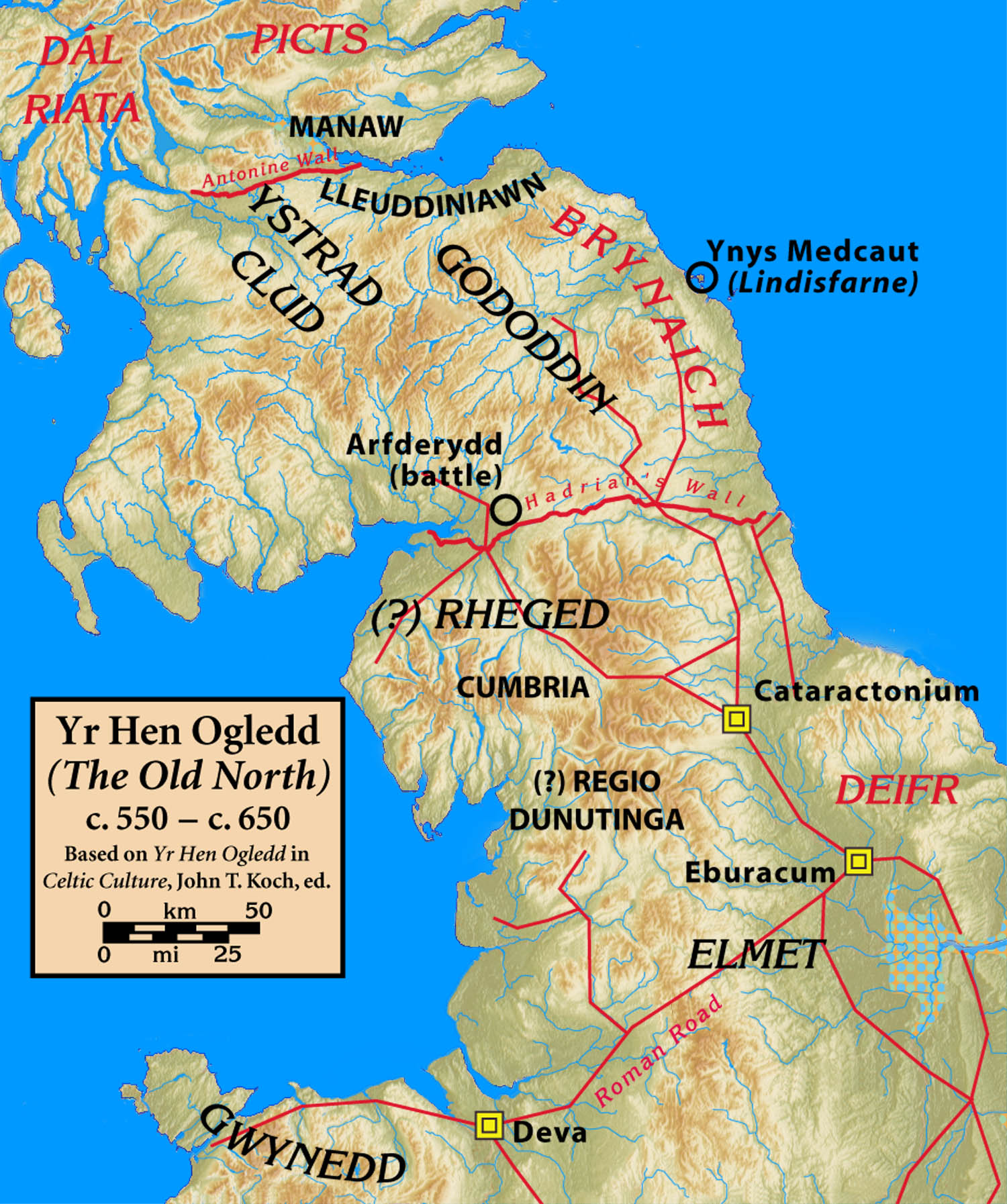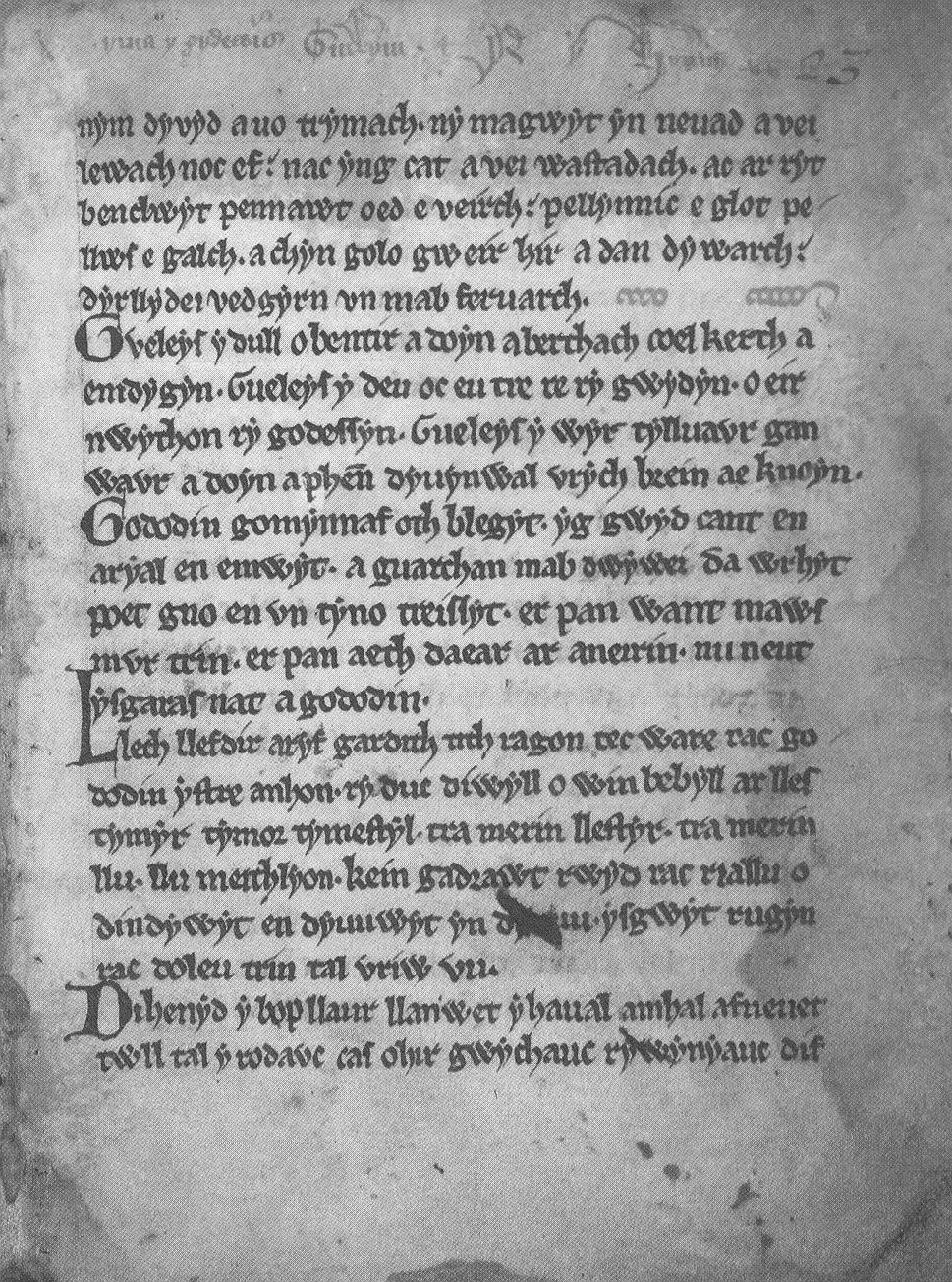|
Coel Hen
Coel (Old Welsh: ''Coil''), also called ''Coel Hen'' (Coel the Old) and King Cole, is a figure prominent in Welsh literature and legend since the Middle Ages. Early Welsh tradition knew of a Coel Hen, a 4th-century leader in Roman Britain, Roman or Sub-Roman Britain and the progenitor of several kingly lines in Hen Ogledd, Yr Hen Ogledd (the Old North), a region of the Brittonic languages, Brittonic-speaking area of what is now northern England and southern Scotland. Later medieval legend told of a Coel, apparently derived from Coel Hen. He was said to be the father of Helena, mother of Constantine I, Saint Helena of Constantinople and through her the grandfather of Roman Emperor Constantine the Great. Although it is likely to be erroneously identifying Saint Elen, Saint Helen of Caernarfon. Other similarly named characters may be confused or conflated with the Welsh Coel. The legendary "King Coel" is sometimes supposed to be the historical basis for the popular nursery rhym ... [...More Info...] [...Related Items...] OR: [Wikipedia] [Google] [Baidu] |
History Of The Kings (f
History is the systematic study of the past, focusing primarily on the Human history, human past. As an academic discipline, it analyses and interprets evidence to construct narratives about what happened and explain why it happened. Some theorists categorize history as a social science, while others see it as part of the humanities or consider it a hybrid discipline. Similar debates surround the purpose of history—for example, whether its main aim is theoretical, to uncover the truth, or practical, to learn lessons from the past. In a more general sense, the term ''history'' refers not to an academic field but to the past itself, times in the past, or to individual texts about the past. Historical research relies on Primary source, primary and secondary sources to reconstruct past events and validate interpretations. Source criticism is used to evaluate these sources, assessing their authenticity, content, and reliability. Historians strive to integrate the perspectives o ... [...More Info...] [...Related Items...] OR: [Wikipedia] [Google] [Baidu] |
Harleian Genealogies
__NOTOC__ The Harleian genealogies are a collection of Old Welsh genealogies preserved in British Library, Harley MS 3859. Part of the Harleian Library, the manuscript, which also contains the '' Annales Cambriae'' (Recension A) and a version of the '' Historia Brittonum'', has been dated to ''c.'' 1100, although a date of c.1200 is also possible.Siddons, "Genealogies, Welsh," pp. 800-2; Remfry, P.M., 'Annales Cambriae. A Translation...', p. 4. Since the genealogies begin with the paternal and maternal pedigrees of Owain ap Hywel Dda (d. 988), the material was probably compiled during his reign. The collection also traces the lineages of less prominent rulers of Wales and the Hen Ogledd. Some of the genealogies reappear in the genealogies from Jesus College MS 20. The collection features the oldest genealogies of Welsh royal families, and include the dynasty of Cunedda (Cunedag), all the way to Beli Mawr, as head of the house of Gwynedd The House of Gwynedd was a royal ... [...More Info...] [...Related Items...] OR: [Wikipedia] [Google] [Baidu] |
Y Gododdin
''Y Gododdin'' () is a medieval Welsh poem consisting of a series of elegies to the men of the Brittonic kingdom of Gododdin and its allies who, according to the conventional interpretation, died fighting the Angles of Deira and Bernicia at a place named '' Catraeth'' in about AD 600. It is traditionally ascribed to the bard Aneirin and survives only in one manuscript, the " Book of Aneirin". The Book of Aneirin manuscript is from the later 13th century, but ''Y Gododdin'' has been dated to between the 7th and the early 11th centuries. The text is partly written in Middle Welsh orthography and partly in Old Welsh. The early date would place its oral composition soon after the battle, presumably in the ''Hen Ogledd'' ("Old North"); as such it would have originated in the Cumbric dialect of Common Brittonic.Elliott (2005), p. 583. Others consider it the work of a poet from Wales in the 9th, 10th, or 11th century. Even a 9th-century date would make it one of the oldest surv ... [...More Info...] [...Related Items...] OR: [Wikipedia] [Google] [Baidu] |
Edinburgh
Edinburgh is the capital city of Scotland and one of its 32 Council areas of Scotland, council areas. The city is located in southeast Scotland and is bounded to the north by the Firth of Forth and to the south by the Pentland Hills. Edinburgh had a population of in , making it the List of towns and cities in Scotland by population, second-most populous city in Scotland and the List of cities in the United Kingdom, seventh-most populous in the United Kingdom. The Functional urban area, wider metropolitan area had a population of 912,490 in the same year. Recognised as the capital of Scotland since at least the 15th century, Edinburgh is the seat of the Scottish Government, the Scottish Parliament, the Courts of Scotland, highest courts in Scotland, and the Palace of Holyroodhouse, the official residence of the Monarchy of the United Kingdom, British monarch in Scotland. It is also the annual venue of the General Assembly of the Church of Scotland. The city has long been a cent ... [...More Info...] [...Related Items...] OR: [Wikipedia] [Google] [Baidu] |
Eidyn
Eidyn was the region around modern Edinburgh in sub-Roman and early medieval Britain, approximately during the 5th–7th centuries. It centred on the stronghold of Din Eidyn, thought to have been at Castle Rock, now the site of Edinburgh Castle, and apparently included much of the area below the Firth of Forth. It was the most important district of the Brittonic kingdom of Gododdin, and a significant power in the Hen Ogledd, or Old North, the Brittonic-speaking area of what is now southern Scotland and northern England. The site of Din Eidyn has been nearly continuously occupied since the Bronze Age, serving as a stronghold of the Votadini during the Roman era and later the principal centre of their successors, the Gododdin kingdom. Eidyn's importance to the Hen Ogledd is reflected in the medieval poem ''Y Gododdin'', which concerns a war band that gathered there for a raid around AD 600. After years of decline, Eidyn was conquered by the Angles in 638. Eidyn is the source ... [...More Info...] [...Related Items...] OR: [Wikipedia] [Google] [Baidu] |
Clydno Eiddin
Clydno Eidyn was a ruler of Eidyn, the district around modern Edinburgh, in the 6th century. Eidyn was a district of the Gododdin kingdom in the Hen Ogledd, or "Old North", the Brittonic-speaking parts of Northern England and southern Scotland in the Early Middle Ages. Clydno became a figure in Welsh tradition. History The Harleian genealogies give Clydno's pedigree. He is said to be the son of a certain Cinbelim or Cynfelyn, the son of Dumnagual Hen, an early ruler of Alt Clut (later known as Strathclyde). The later genealogy ''Bonedd Gwŷr y Gogledd'' gives an altered version of this genealogy; here Cynfelyn is Clydno's grandfather, and the family is attached to the line of the ancestor figure Coel Hen.Bromwich, pp. 256–257. An attack by Clydno and several other northern rulers on Gwynedd in North Wales is recounted in the Gwynedd version of the Welsh laws preserved in the '' Book of Chirk''.Bromwich, p. 491 According to the story, after Elidir Mwynfawr, a prince of the No ... [...More Info...] [...Related Items...] OR: [Wikipedia] [Google] [Baidu] |
Peredur
Peredur (, Old Welsh ''Peretur'') is the name of a number of men from the boundaries of history and legend in sub-Roman Britain. The Peredur who is most familiar to a modern audience is the character who made his entrance as a knight in the Arthurian world of Middle Welsh prose literature. Gwrgi and Peredur, sons of Eliffer Gwrgi and Peredur are listed as sons of Eliffer (Old Welsh: ''Elidir'' or ''Eleuther'') "of the great warband" (''cascord maur'') and as sons of the Coeling dynasty in the Harleian genealogies, making them first cousins of Urien.Koch, "Peredur fab Efrawg", pp. 1437–8. Likewise, a pedigree from Jesus College MS 20 includes Gwrgi and Peredur as brothers together with one Arthur ''penuchel''. Their principal claim to fame rests on their having fought in the Battle of Arfderydd. The ''Annales Cambriae'' report that this battle (''bellum Armterid'') was fought in 573, but gives no further detail.Koch, "Arfderydd", pp. 82–3. A later expansion of the entry ... [...More Info...] [...Related Items...] OR: [Wikipedia] [Google] [Baidu] |
Elmet
Elmet (), sometimes Elmed or Elmete, was an independent Brittonic Celtic Cumbric-speaking kingdom between about the 4th century and mid-7th century. The people of Elmet survived as a distinctly recognised Brittonic Celtic group for centuries afterwards in what later became the smaller area of the West Riding of Yorkshire, and now West Yorkshire, South Yorkshire and north Derbyshire. Geography The precise borders of the original kingdom of Elmet are unclear. It may have been bounded by the rivers Sheaf in the south and Wharfe in the east until the 7th century. To the north it adjoined the kingdom of Deira and Mercia to the south, while its western boundary appears to have been near Craven, which was possibly another minor British kingdom. As such, it was not conterminous with other territories of the Britons at the time, being well to the south of others in the ''Hen Ogledd'' ("Old North"), such as Strathclyde, and north-east of Wales, Cornwall and Dumnonia. As one o ... [...More Info...] [...Related Items...] OR: [Wikipedia] [Google] [Baidu] |
Rheged
Rheged () was one of the kingdoms of the ('Old North'), the Brittonic-speaking region of what is now Northern England and southern Scotland, during the post-Roman era and Early Middle Ages. It is recorded in several poetic and bardic sources, although its borders are not described in any of them. Archaeological work from 2012 onwards on a site in Galloway in Scotland is interpreted by the excavators as showing that it is a royal centre of Rheged. Rheged possibly extended into Lancashire and other parts of northern England. In some sources, Rheged is intimately associated with the king Urien Rheged and his family. Its inhabitants spoke Cumbric, a Brittonic dialect closely related to Old Welsh. Etymology The origin of the name ''Rheged'' has been described as "problematic". One Brittonic-language solution is that the name may be a compound of ''rö-'', a prefix meaning "great", and ''cę:d'' meaning "wood, forest" (cf. Welsh ''coed'') although the expected form in Welsh wou ... [...More Info...] [...Related Items...] OR: [Wikipedia] [Google] [Baidu] |
Urien Rheged
Urien ap Cynfarch Oer () or Urien Rheged (, Old Welsh: or , ) was a powerful sixth-century Common Brittonic, Brittonic-speaking figure who was possibly the ruler of the territory or kingdom known as Rheged. He is one of the best-known and best documented of the Ancient Britons, British figures of the 'Yr Hen Ogledd, Old North'. His kingdom was most likely centred around the Solway Firth. According to the ''Historia Brittonum'' (), Urien gained the decisive advantage in a conflict against the Anglo-Saxons in northern Britain led an alliance with three other kings: Rhydderch Hen, Gwallog ap Llênog, and Morcant Bulc, Morgan. The alliance led by Urien penned the Anglo-Saxons in at Lindisfarne, though this siege came to an abrupt end when Urien was murdered on the orders of his erstwhile ally Morgan. The most secure evidence for his existence comes the ''Historia Brittonum'' and eight Panegyric, praise-poems in Middle Welsh dedicated to him surviving in a Book of Taliesin, four ... [...More Info...] [...Related Items...] OR: [Wikipedia] [Google] [Baidu] |



